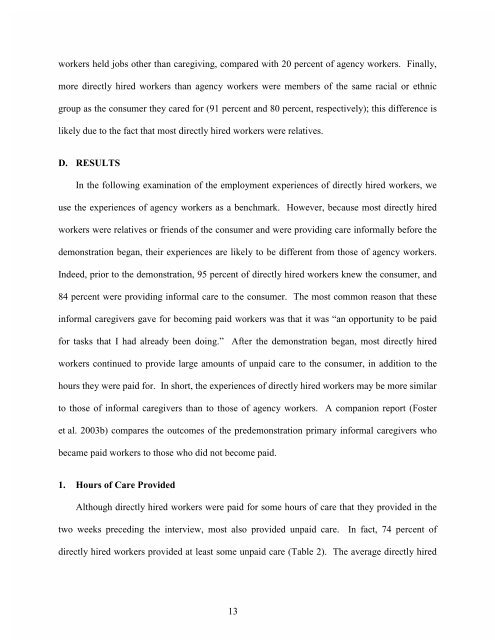The Experiences of Workers Hired Under Consumer Direction in ...
The Experiences of Workers Hired Under Consumer Direction in ...
The Experiences of Workers Hired Under Consumer Direction in ...
You also want an ePaper? Increase the reach of your titles
YUMPU automatically turns print PDFs into web optimized ePapers that Google loves.
workers held jobs other than caregiv<strong>in</strong>g, compared with 20 percent <strong>of</strong> agency workers. F<strong>in</strong>ally,more directly hired workers than agency workers were members <strong>of</strong> the same racial or ethnicgroup as the consumer they cared for (91 percent and 80 percent, respectively); this difference islikely due to the fact that most directly hired workers were relatives.D. RESULTSIn the follow<strong>in</strong>g exam<strong>in</strong>ation <strong>of</strong> the employment experiences <strong>of</strong> directly hired workers, weuse the experiences <strong>of</strong> agency workers as a benchmark. However, because most directly hiredworkers were relatives or friends <strong>of</strong> the consumer and were provid<strong>in</strong>g care <strong>in</strong>formally before thedemonstration began, their experiences are likely to be different from those <strong>of</strong> agency workers.Indeed, prior to the demonstration, 95 percent <strong>of</strong> directly hired workers knew the consumer, and84 percent were provid<strong>in</strong>g <strong>in</strong>formal care to the consumer. <strong>The</strong> most common reason that these<strong>in</strong>formal caregivers gave for becom<strong>in</strong>g paid workers was that it was “an opportunity to be paidfor tasks that I had already been do<strong>in</strong>g.” After the demonstration began, most directly hiredworkers cont<strong>in</strong>ued to provide large amounts <strong>of</strong> unpaid care to the consumer, <strong>in</strong> addition to thehours they were paid for. In short, the experiences <strong>of</strong> directly hired workers may be more similarto those <strong>of</strong> <strong>in</strong>formal caregivers than to those <strong>of</strong> agency workers. A companion report (Fosteret al. 2003b) compares the outcomes <strong>of</strong> the predemonstration primary <strong>in</strong>formal caregivers whobecame paid workers to those who did not become paid.1. Hours <strong>of</strong> Care ProvidedAlthough directly hired workers were paid for some hours <strong>of</strong> care that they provided <strong>in</strong> thetwo weeks preced<strong>in</strong>g the <strong>in</strong>terview, most also provided unpaid care. In fact, 74 percent <strong>of</strong>directly hired workers provided at least some unpaid care (Table 2). <strong>The</strong> average directly hired13
















